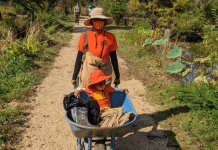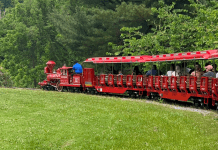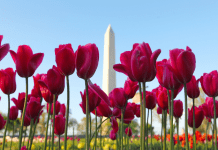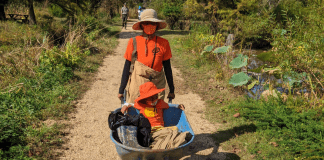“Frederick Douglass!” my son exclaimed excitedly, pointing his tiny finger at an abstract painting. We were at Simple Bar, a local restaurant with really great art (and food) in our Brightwood neighborhood.
My husband and I looked at each other and smiled. It’s fun when our son makes a connection with something outside of the experience where he learned about it. It’s obvious that these experiences really make an impact. We took our son to the Frederick Douglass National Historic Site about a year ago when he was just about 2. Now he points out Frederick Douglass whenever he sees pictures of him. It seems that we take him to a lot of places that have pictures of Frederick Douglass, which is telling of where we live.
With all the museums, national historic sites, and memorials in Washington, there’s no shortage of ways to teach children about U.S. history and our nation’s leaders. And that’s an opportunity I want to seize, given that that’s not normal anywhere else. I grew up in Maine, where there aren’t a ton of places to go to learn about black history and the civil rights movement. Here in Washington, there are so many places to go to learn. I feel that it’s important to take advantage of that. It’s important to me that my children be able to recognize and see that leaders can be of any race and gender. And that’s just one reason why we choose to explore places where we can learn about black history and the history of cultures outside of our own.
I am grateful for the resources we have in Washington, D.C. that allow history to come to life in many different ways. Here are a few of my favorite spots in Washington, D.C. to learn about black history:
Carter G. Woodson Home National Historic Site
When I stepped into the Carter G. Woodson home and learned about his work in preserving African American history, I was deeply humbled. It’s because of his work that we know as much as we do about Americans of African descent and the stories of the struggles and challenges that led to what’s happening with the civil rights movement today. Despite being in the National Park system for some time, the site just opened in 2017. When we visited, the home had little inside except for a bookcase of Carter G. Woodson’s work. The guided tour is totally worth the visit, and don’t forget to check out the statue of Carter G. Woodson nearby.
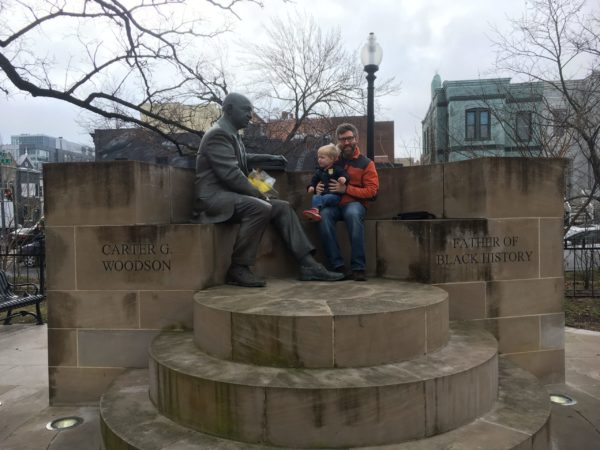
The African American Civil War Memorial and Museum
Located in the heart of the U Street neighborhood, I’m surprised that I don’t see more people checking out this memorial. During the Civil War, over 200,000 men served in the U.S. Army and Navy. Their efforts helped free over four million slaves. The walls surrounding the statue in the memorial contain the names of those who fought. There are so many names! After visiting the memorial, cross the street and check out the museum. The museum itself appears really small, but it is not lacking in imagery and information. This is the place to go to learn about black history from the first slaves up through Obama’s presidency. The museum celebrates the men and women who bravely fought for civil rights, and it’s an incredible place to learn, reflect, and explore.
Frederick Douglass National Historic Site
We went to the Frederick Douglass National Historic Site on a rainy Saturday. I recommend calling ahead and reserving a spot on a guided tour, otherwise, you may have to wait for a tour or you could be turned away completely. Despite the weather, for example, the tours were nearly booked up in advance! The only way inside the house is by joining a guided tour. The tour of the house has a lot to offer, and there is plenty to look at and listen to. I wouldn’t say it’s the most engaging place for a toddler, but our son was really taken by the pictures of Frederick Douglass and as mentioned previously, he really took a lot from the experience. The visitors center also has a film about Frederick Douglass, which I recommend watching before going on the tour.

Mary McLeod Bethune Council House
The Mary McLeod Bethune Council House is another place with incredible history. It was the first headquarters of the National Council of Negro Women (NCNW), and our visit taught me so much about Mary McLeod Bethune’s commitment to education, civil rights, and the advancement of African American women. The guided tour highlights her personal story, which is incredible. I was especially inspired by her impact on the civil rights movement and the Washington, D.C. community. For example, she worked closely with Carter G. Woodson on preserving African American history. Given how close their houses are in D.C., I could imagine them walking together in the neighborhood. What I also love is that this place illustrates the impact of black women leaders, which is such an important lesson for our children today.
D.C. Neighborhood Heritage Trails
My interest in black history really began when I stumbled upon a D.C. Neighborhood Heritage Trail. I didn’t know that much about black history at the time, and when I read the sign, I realized how important it was to continue learning since I was living in a neighborhood that had such a rich history rooted in the civil rights movement. I’ve been in Washington, D.C. for nearly 20 years, and one truly cannot know the city without acknowledging and learning about black history. The D.C. Neighborhood Heritage Trails are an incredible resource, and they are a wonderful way to explore the city with your children while learning about the history of right where you are standing. Want to know what happened in that house right there? Just look at the sign on the corner! Washington, D.C. has an incredible history, and it’s not lacking in stories related to black history and the civil rights movement. Not all of the stories are good stories, and that’s important for children to learn about. But some of the stories are happy stories. And I think those stories are also part of growing and engaging in the civil rights movement as well.
Additional Places to Check Out
Right now, at age 3, my son is starting to recognize people in pictures. While it might not be impressive to some that he can recognize someone as famous as Frederick Douglass, I expect when he’s older that he will be able to recall his contributions and challenges that led to overcoming adversity and making an impact on African American lives today. Because children pick up new things every time they visit a place, it’s important to me that I continue to bring my son to these places so that he can continue to learn and grow.
We still have many places to go in Washington to learn about black history, and the following spots are on our list.
Here are 5 more places to learn about black history:
- Anacostia Community Museum
- Charles Sumner School Museum and Archives
- Emancipation Memorial
- Moorland Spingarn Research Center at Howard University
- National Museum of African American History and Culture
Have you visited any of these places with your children? What do you learn every time you go? Please comment below with ideas on where to go to learn about black history in Washington, D.C.


